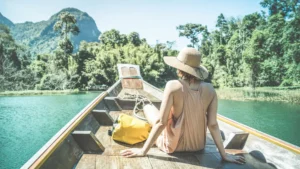Sailing into the quiet bay of Coron on the first day of 2009, I found myself counting life’s blessings as I gazed at the limestone islands and white sandy beaches, the northeasterly breezes blowing all my worries away. On the deck, budding photographers clicked away at the passing scenery while other holiday makers sunned themselves in lounging chairs.
We were on the maiden voyage of 7107 Islands Cruise, a medium-sized luxury vessel that promises to ease travel between the party island of Boracay in the Visayas and the more laid-back chain of islands in the Calamianes, which includes Coron. Tourists can fly to either destination and cross over aboard the ship, with the option of making the vessel their floating hotel during their holidays. The choice is especially appealing in Coron, where posh lodging and restaurants are hard to come by.
At the Coron port, guests made their selection from local tour packages. One group chose a relaxing dip at the Maquinit Hot Springs, perfect for soothing cramped muscles after several hours of sunbathing on the ship’s deck. The more athletic ones who were not afraid of chilly waters went for an adventurous swim at the Twin Lagoons, which could be reached by going through a rocky entrance to emerge in an enclosed beach. With my traveling companion Ibarra, I opted to finally make the arduous (for me, at least) climb to Mount Tapyas, actually just a grassy hill overlooking the town proper of Coron. There were supposed to be 700 steps on the concrete stairway, and it did feel like we had trudged up hundreds of steps by the time we reached the top.
The balmy breeze from the sea calmed the spirit, even as we had to share space with a cheerful family enjoying a picnic on the semi-circular view deck. The wide open area made it a popular hangout for locals, and we passed couples or groups of young people sitting on the covered rest stations as we made our way down.
The following day, the ship lifted anchor and sailed to Malcapuya Island, near the island of Culion. It was fascinating to watch the ship’s pontoon ferrying the guests to the fine white sands of the island, where a lavish picnic lunch complete with roast suckling pig awaited us. The floating platform seemed to hover uncertainly on the choppy waters but the group made it safely out to the island and back to the ship, all wearing requisite life vests. Ibarra and I played it safe and took the more conventional speed boat to the island.
Comprising 680 of the Philippine archipelago’s more than 7,000 islands, the Calamianes chain presents a rare opportunity for travelers to explore several natural attractions in one destination. There are lush mangrove forests traversed by quiet rivers that flow out to the sea, where colorful birds can be seen during late afternoon boat rides. Scuba divers love to descend in the crystal-clear waters of the lakes that lie hidden in the massive rocky outcrops of Coron Island. Around most of the islands, stunning coral reefs provide a colorful playground for a wide variety of fish and other undersea creatures. Near Calauit Island, lucky divers and snorkelers may spot the elusive dugong or sea cow, which feeds on sea grass, or the endangered marine turtle.
“What better way is there to see all these than through a cruise ship?” cruise ship owner Steve Tajanlangit reasons out. With a well-appointed ship that once cruised the Mediterranean and Andaman seas, the newest kid on the tourism block presents a refreshing style of island hopping once its operations are fine-tuned to meet the demands of discriminating guests.
Even with well-heeled travelers on board, no one was inclined to buy expensive birds’ nests as souvenirs from Coron. Instead, many of the Manila-based guests chose to bring home loads of dried fish, displayed in abundance on the stalls just outside the gate of the port. Ibarra and I settled for gray “Dive Coron” t-shirts that had drawings of Japanese shipwrecks at the back, one more reason to make a return trip to Coron when summer comes around.
Insight
The Tagbanuas
The islands in the Calamianes are home to the Tagbanua people, an indigenous community that makes a living during the dry season by climbing the steep cliffs to collect birds’ nests, an important ingredient in Chinese cuisine and medicine. Unlike the forest dwelling Tagbanua in the Palawan mainland, the Tagbanua in the Calamianes are seafarers who depend on fishing as their main livelihood. Recognizing their culture, the government has granted Coron Island and its surrounding seas to the community as their ancestral domain. Although gentle and friendly, the Tagbanuas are assertive of their territorial rights and still practice their indigenous justice system, which may be applied to outsiders who violate their laws. They comprise about one fourth of the population in the municipality of Coron, and are also found in Bulalacao Island as well as Buenavista.







